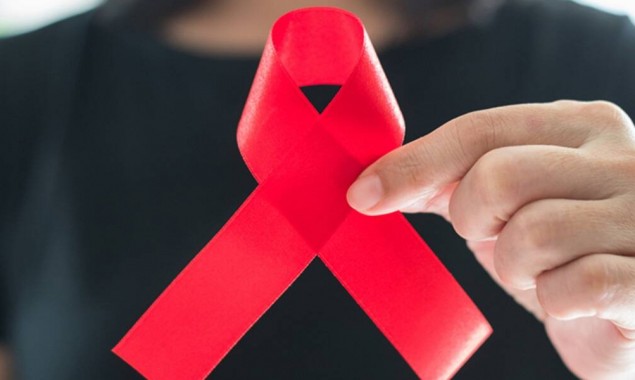Synopsis
Virus-related mortality rates on the rise in parts of Pakistan owing to late diagnosis, poor adherence to treatment

Photo: File
KARACHI: HIV/AIDS-related mortality rates are rising in parts of Pakistan due to late diagnosis and poor adherence to treatment, according to the latest UNAIDS Pakistan report.
About half of the key populations suffering from the disease in the country were not aware of their HIV status, resulting in onward transmission and AIDS-related deaths that were being prevented in other Asian countries through assisted testing.
All major cities of Pakistan along with the rest of the world marked World AIDS Day on December 1. Amongst other events, Karachi commemorated the day — which was first observed by the UN in 1988 — with an awareness walk organised by the Sindh Communicable Diseases Control (CDC) in collaboration with United Nations AIDS (UNAIDS) at Clifton beach.
The day is commemorated worldwide to spread awareness among the public about the sexually transmitted disease (STD) especially in metropolises where reportedly the transmission rate was higher. The AIDS outbreak is widely considered to be one of two major pandemics, the other being Covid-19.
However, these activities by the health authorities concerned have largely failed to address the growing challenges faced by people living with HIV (PLHIV).
According to the report titled Seizing the Moment, the infections in the Asia region had declined slightly with fewer cases being reported in countries like Thailand, Vietnam and Myanmar. This progress, however, was offset by countries like Pakistan where the disease was actively spreading, the report stated.
Failed approaches
Sindh CDC Additional Director Dr Ershad Kazmi said the reasons behind the sharp increase in new infections was the failure to put in place a combination of biomedical, behavioural and structural approaches to managing the HIV crisis. “The focus of HIV prevention should be on those who are at a greater risk of getting infected. Consistent use of barrier devices, although possible, has proved difficult to achieve among our population. Women need greater agency and support to be able to negotiate how they protect themselves from STDs”.
He added that stagnation in people receiving antiretroviral therapy (ART) treatment may have happened due to work-related and social-related travel. “Such travelling can affect adherence to ART. Spending long periods away from home and occasionally carrying fewer antiretroviral (ARV) pills than needed is another reason. PLHIV often fear being stigmatised,” he added.
Moreover, he stated, skipping the medicine due to alcohol consumption are also possible factors. Regarding the rampant use of therapeutic injections, the CDC additional director said that unsafe injection usages result in a substantial burden of preventable blood-borne viral (BBV) disease like HCV and HIV, which is alarming.
“In Sindh, it was revealed that unsafe injections are being used by untrained staff at clinics to administer the dosage. They have been frequently using medically discarded injections and also performing minor surgical procedures,” Dr Kazmi told Bol News.
Strict action against fake medical practitioners should be taken, he urged the authorities concerned.
Registering patients
He insisted that registration of PLHIV was necessary to curb the pandemic. “Strong coordination maintained between the PLHIV and their healthcare providers is crucial for adherence to antiretroviral therapy. Counselling of the PLHIV and screening of their families along with their counselling will consequently educate society into not becoming a source of spreading the disease”, he added.
He revealed that Sindh CDC did not let the Covid-19 pandemic affect HIV testing. “The 16 ART centres functional in Sindh have a strong follow-up mechanism in place. Counsellors of each centre call the PLHIV for follow-up to ensure the patient does not miss their dose”, the Sindh CDC additional director claimed.
There are more concerns over the stigmatisation of the vulnerable transgender community, the senior health official feared.
“Overlapping social, cultural, legal and economic factors contribute to pushing transgender people to society’s margins. They are more likely to encounter problems of discrimination, limiting their educational and economic opportunities. These challenges are exacerbated by a lack of recognition of their gender and the absence of anti-discrimination legislation and policies that explicitly include transgender people”, Dr Kazmi stated.
In addition to this, because sex work and drug use were illegal in Pakistan, sex workers who use drugs were more vulnerable to occasional arrests, bribes, extortion and sexual abuse, he explained. “In turn, this discourages many sex workers who inject drugs from seeking HIV prevention and ART treatment. Migration and sex work are often linked as some migrants may turn to sex work if they cannot find an alternative means of income”, he also said.
According to the UNAIDS Pakistan website, some new HIV infections have risen sharply since 2006 – from less than 200 new infections in 2006 to around 8,200 new infections in 2020.
Adil Qadir, a healthcare worker at a community-based organisation advocating for male reproductive and sexual health rights in the metropolis, echoed the CDC official’s claims and stated that some of the underlying trends that have led to this sharp increase in the HIV cases in Sindh over the years was the sharing of unsterilised needles during drug injection and the frequent unsafe sexual practices of people, particularly men. Once the infection reaches a plateau among those people who use unhygienic needles to inject drugs, it eventually reaches the general population through sexual networks, he elaborated.
The UNAIDS Pakistan data also shows that coverage of people receiving ART treatment increased over the past decade from 3 per cent in 2010 to 12.5pc in 2019. The figure was slightly below 12.5pc in 2020, but overall, the demand for ART treatment had increased. PLHIV need the ARV drugs in order to survive, Qadir said.
Regarding the rampant use of therapeutic injections, the healthcare worker said that unsterilised syringes were not as commonly used in the region, but there were definitely some areas where it was a major cause behind the spread of HIV.
Risk factors
“If we put them in order, needle-sharing for drug injections, unsafe sexual practices, mother-to-child transmission during pregnancy, delivery or breastfeeding and the transfusion of infected blood are the major causes of the spread of disease in Karachi as well as the rest of Sindh”, Qadir explained.
He said that registration of the HIV-infected people with the health authorities concerned was crucial to tackle the HIV/AIDS pandemic. “The contributions of Sindh CDC had significantly reduced the spread of the disease. Government measures have also helped tackle the crisis. The HIV treatment centres have been set up all over the province”, he informed.
The healthcare worker argued that there was a need to empower non-governmental organisations if the provincial government was serious about eliminating the disease. “There are some well-intended organisations that aim to improve the welfare, sexual health and human rights situation for men”, he claimed.
He elaborated that basic services including psychosocial counselling, clinical sexually transmitted infections (STI) screening and treatment, voluntary counselling and testing (VCT), mobile VCT for HIV, referral for HIV management as well as provision of barrier devices through service delivery centres and outreach field workers was the need of the hour.
“Barrier devices should be made free for vulnerable groups including sex workers, transgender persons and injecting drug users to prevent further spread of STIs”.
Legal complications
Aasia Munir, a lawyer who serves as an officer at the Aurat Foundation, a women’s rights organisation, told Bol News that the Sindh HIV and AIDS Control Treatment and Protection Act, 2013 included setting up commissions with governing and working bodies comprising of multiple members which could slow down the implementation process of the law meant to protect the PLHIV.
The drafting of this law created a labyrinth of definitions and a proliferation of provisions that, when tackling the HIV/AIDS crisis in Sindh, give rise to unnecessary complexity. Understanding this HIV protection act is much like unboxing Russian nesting dolls, she said.
“There are many other matters that may take a very long time to implement. To put it simply, complying with this legislation is more difficult than it needs to be. Because when there are so many provisions in a law, then it creates hurdles during the implementation process,” the lawyer further said.
“Adopting such lengthy procedures can be very difficult. The more a legislation is streamlined, the easier it is for authorities concerned to adopt its procedures. And the subsequent implementation will also send a clear message to the public affected by the law of how the act aims to serve them”, she stated.
Speaking about the Sindh Reproductive Healthcare Rights Act, 2019, she said the core idea of the bill is to promote reproductive healthcare. The provisions are intended to ensure the right to be protected from STDs such as HIV.
“The authorities concerned will not have to face many hurdles during the implementation process while delivering reproductive healthcare rights of men and women”, she also said and added “A lot of matters in the 2019 law will be implemented with immediate effect. The act has public awareness clauses and the registration procedure is also easy. To facilitate reproductive health rights in the province, the act also provides a confidential environment during counselling and services which will encourage informed choice for patients. The people of Sindh will likely benefit from the provisions set in the law”.
The HIV/AIDS pandemic has continued to affect thousands of people in the province. Healthcare workers, medical experts and lawyers remain hopeful that there were ways in the province to take preventive measures and avoid being infected. This is possible at both individual and collective level.
Barrier devices were the first step to prevent possible infections while the antiretroviral therapy provided a method to treat the human immunodeficiency virus, if taken seriously. This method involved taking a series of medicines through an HIV regimen. Those affected by the disease as well as the people responsible for taking care of them would be required to follow official medical guidelines to prevent any possible outbreaks.
Non-governmental organisations continue their fight against the disease but there was a need for establishing norms which could facilitate equitable access to both barrier devices as well as treatment options for PLHIV. As stigmatisation continued in a society already plagued by classism, platforms were necessary to raise voices of different people against the strong disapproval, discrimination and, simply put, hatred against people struggling with the virus.
Moreover, as the near-term prospect for reducing the HIV infections in Sindh and the implementation of proper drafting of legislation remains grim, this should urge the provincial government to at least seek to register more PLHIV and offer them mobile voluntary counselling and treatment to prop up a fight against a pandemic which had so far been hindered by a fragmented national response.
Catch all the Pakistan News, Breaking News Event and Latest News Updates on The BOL News
Download The BOL News App to get the Daily News Update & Follow us on Google News.




